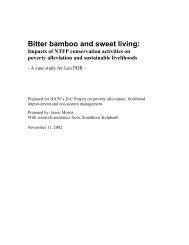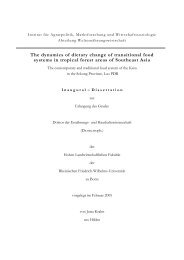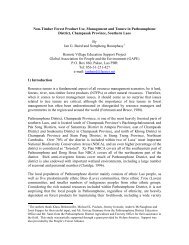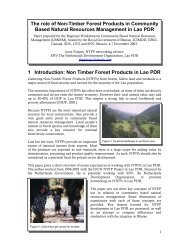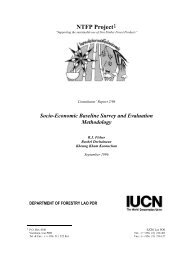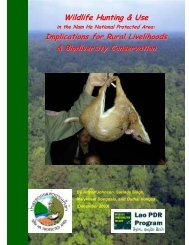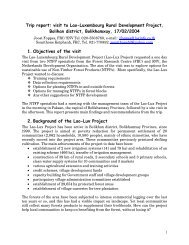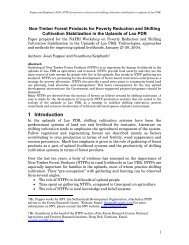Create successful ePaper yourself
Turn your PDF publications into a flip-book with our unique Google optimized e-Paper software.
2.2 Semi-structured interviews with key informants, cross-checking<br />
At our first entry into the district or into a village, we would interview the district authorities<br />
or the village headman. Such interviews provided us not <strong>on</strong>ly with preliminary data <strong>on</strong> NTFP<br />
use but would also create an understanding of the nature of our ask which made it easy to<br />
arrange subsequent meetings with villagers. Any existing statistics <strong>on</strong> village ec<strong>on</strong>omy or<br />
NTFP use would be collected as well. These data are often useful to cross-check with data<br />
derived from other methods. The technique of a semi-structured interview includes preparing<br />
a checklist of questi<strong>on</strong>ed beforehand, using open-ended questi<strong>on</strong>s that seek explanati<strong>on</strong> rather<br />
than a yes or a no answer. For example we would rather ask “where do you collect NTFP’s?”<br />
rather than “do you collect NTFP’s from the protected forest?”. This technique was also used<br />
for interviewing local traders in NTFP’s.<br />
2.3 Structured group meetings<br />
A lot of RRA work was d<strong>on</strong>e in structured group meeting, usually in the evenings, when<br />
people have time to join. During such meetings we would build rapport, do sketch mapping,<br />
listing and ranking of NTFP’s, income/expenditure ranking, wealth ranking. These meetings<br />
require a good facilitator, who is able to ensure that all participants understand the purpose of<br />
the meeting, who can encourage equal participati<strong>on</strong> of all participants, who can keep the<br />
group to follow the agreed agenda, yet remaining flexible and able to change the agenda<br />
according to the requirements of the group. In each village, we worked with groups of men<br />
and women separately to allow different roles, knowledge and opini<strong>on</strong>s to become visible. In<br />
mixed groups, women do not always have an opportunity to make themselves heard<br />
2.4 Participatory sketch mapping<br />
We asked men and women separately to draw participatory maps of their village and<br />
surrounding collecti<strong>on</strong> area’s. People could choose to use either local material such as sand,<br />
sticks, st<strong>on</strong>es, or paper and markers, provided by the project, to draw maps. This activity was<br />
usually our starter activity, because it creates a fun atmosphere and allowed many pers<strong>on</strong>s to<br />
participate. These maps would show where the most important village land use areas were,<br />
what products would be collected from each of them. Such informati<strong>on</strong> is a good starting<br />
point for further data gathering and it can be used to decide where to have the forest walk.<br />
We would often come back to look at these maps later <strong>on</strong> in the work, to review added<br />
informati<strong>on</strong> from forest walks etc.<br />
2.5 Listing and ranking of NTFP’s<br />
Separate groups of men and women were asked to write down which NTFP’s were used by<br />
them and to rank them according to priority. The listing of NTFP’s often creates log lists of<br />
products. Criteria used and discussed by villagers for ranking NTFP’s are often importance as<br />
a food resource, income source, or other inputs to the household. The NTFP’s would be<br />
written down by a group member who could write. Little drawings would sometimes be<br />
added for the benefit of those members who could not read. Ranking was d<strong>on</strong>e by assigning<br />
numbers of pebbles or tamarind seeds to each identified NTFP.



